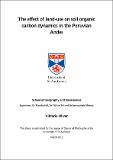Files in this item
The effect of land-use on soil organic carbon dynamics in the Peruvian Andes
Item metadata
| dc.contributor.advisor | Hill, Timothy Charles | |
| dc.contributor.advisor | Teh, Yit Arn | |
| dc.contributor.advisor | Oliveras, Immaculada | |
| dc.contributor.author | Oliver, Viktoria | |
| dc.coverage.spatial | 159 | en_US |
| dc.date.accessioned | 2015-07-28T14:56:39Z | |
| dc.date.available | 2015-07-28T14:56:39Z | |
| dc.date.issued | 2015-06-26 | |
| dc.identifier | uk.bl.ethos.658890 | |
| dc.identifier.uri | https://hdl.handle.net/10023/7064 | |
| dc.description.abstract | Soil carbon storage in tropical ecosystems is important in the global carbon cycle, yet consensus is lacking on how soil organic carbon stocks are altered under anthropogenic land-use change. This thesis seeks to quantify soil carbon stocks, the associated soil carbon emissions and explores the drivers of soil respiration in managed tropical Andean lands over a 2600 m elevation gradient. It investigates: grazing and burning on high altitude montane grasslands, burning in montane forests and agriculture in premontane forests. Changes among land-uses were quantified using belowground carbon stocks, the carbon distribution among density fractions, soil carbon emissions and environmental drivers of soil respiration. Soil respiration was a good proxy of soil carbon loss in premontane pastures and montane grassland soils. The total carbon stocks on some land-uses appeared to be unaffected but the distribution of carbon within the soil had changed and even when there were no net changes in soil carbon emissions, the drivers of respiration were different. The synergistic effect of burning and grazing in montane grasslands was the most detrimental to soil carbon stocks, whereas montane forests were unaffected. In the premontane elevation, soil carbon loss was dependent on the type of agricultural practice but the succession of secondary forest allowed soil carbon to recover to similar levels measured in the mature forest. These findings highlight the fact that although land-use does not always appear to have an obvious effect on total soil carbon stocks, the loss of carbon from short-term labile pools can cause higher carbon emissions and dominate soil-atmospheric feedbacks. Furthermore, the drivers of soil respiration and the synergistic relationship between soil moisture and temperature alter under different land uses. These factors should be taken into consideration with regards to predictions of regional temperature/precipitation climate change and soil carbon management policy in order to arrive at more realistic decisions. | en_US |
| dc.language.iso | en | en_US |
| dc.publisher | University of St Andrews | |
| dc.subject | Soil carbon | en_US |
| dc.subject | Land-use | en_US |
| dc.subject | Soil respiration | en_US |
| dc.subject | Tropics | en_US |
| dc.subject | Peru | en_US |
| dc.subject.lcc | S599.3P4O6 | |
| dc.subject.lcsh | Soils--Carbon content--Peru | en_US |
| dc.subject.lcsh | Land use, Rural--Peru | en_US |
| dc.subject.lcsh | Land use, Rural--Andes | en_US |
| dc.subject.lcsh | Soil respiration--Peru | en_US |
| dc.title | The effect of land-use on soil organic carbon dynamics in the Peruvian Andes | en_US |
| dc.type | Thesis | en_US |
| dc.contributor.sponsor | ACCA - Asociación para la Conservación de la Cuenca Amazónica | en_US |
| dc.contributor.sponsor | Natural Environment Research Council (NERC) | en_US |
| dc.type.qualificationlevel | Doctoral | en_US |
| dc.type.qualificationname | PhD Doctor of Philosophy | en_US |
| dc.publisher.institution | The University of St Andrews | en_US |
| dc.publisher.department | University of Oxford, University of Aberdeen | en_US |
This item appears in the following Collection(s)
Items in the St Andrews Research Repository are protected by copyright, with all rights reserved, unless otherwise indicated.

